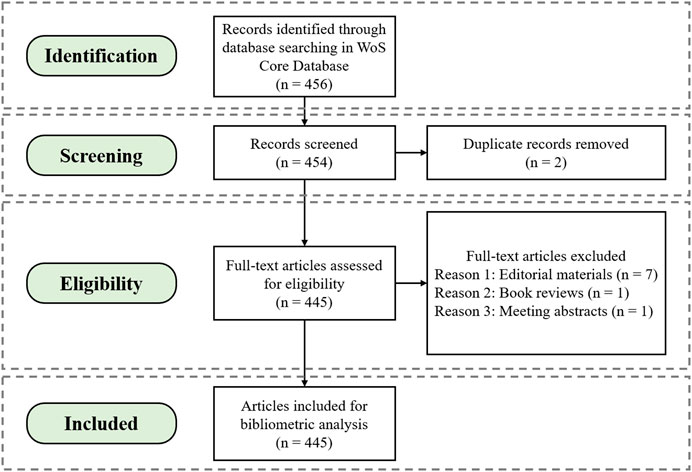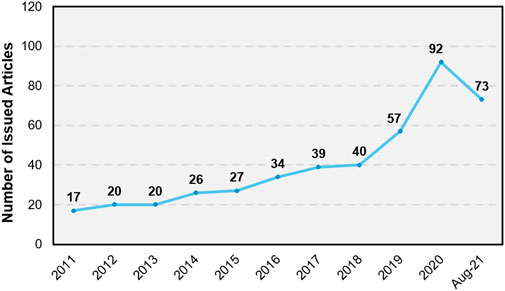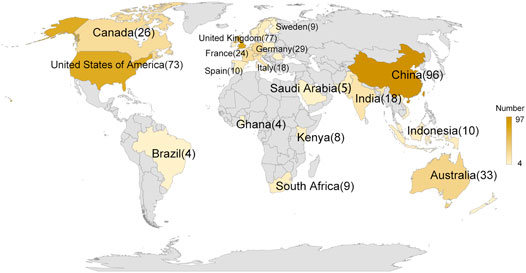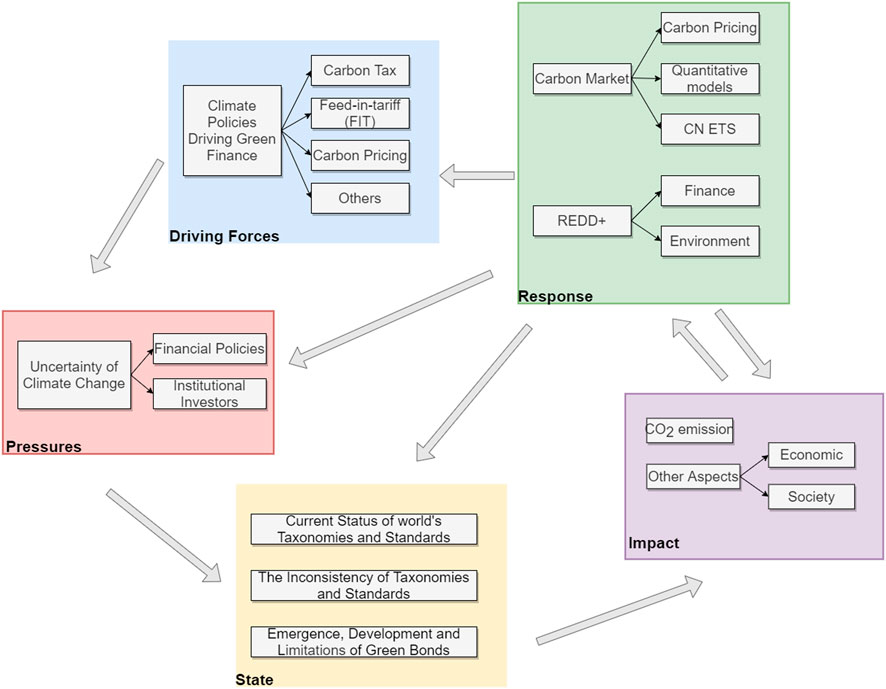- 1Business School, University of Jinan, Jinan, China
- 2Jinan Foreign Language School, Jinan, China
- 3Institute of Green Development, University of Jinan, Jinan, China
Green finance is an emerging topic which is broadly discussed in context of adapting and mitigating environmental deterioration due to climate change. As an effective incentive mechanism, it provides strong support for carbon emission reduction. However, a limited review articles investigate the specific combination of green finance and carbon emission reduction. Here, we apply a bibliometric analysis to review research on green finance and carbon emission reduction based on the literature from 2010 to 2021 in the Web of Science core database. The results indicate that countries with the most publications were those with high economic development, salient environmental problems, and a strong demand for ecological protection. Top publishing journals include Climate Policy, Journal of Cleaner Production, and Energy Policy. The author collaboration is fragmented, mostly less than three researchers. Based on analyses of keyword frequency and centrality, deforestation, carbon markets, and financial development were the most significant research topics. The research hotspots included clean development mechanism, adaptation, carbon market, and sequestration. Finally, the DPSIR framework is applied to explore driving forces, state, pressure, impact and response of current research. We hope our work provides a systematic review of green finance for carbon emission reduction to boost the research in this field.
1 Introduction
With economic and social development, natural systems are undergoing rapid changes, especially due to carbon emissions, which have increased significantly (Figure 1). Although carbon emissions were substantially mitigated during the COVID-19 outbreak, the world’s CO2 emissions still reached 41.4 billion tons in 2020. Excessive carbon dioxide has led to serious global issues, such as glacial melting, sea level rise, and extreme regional climate change (Diffenbaugh et al., 2017; Garbe et al., 2020; Gomez et al., 2020; Tabari, 2020; Yalew et al., 2020), further exacerbating the imbalance of global socioeconomic development (Diffenbaugh and Burke, 2019). Meanwhile, animal migration due to global warming will potentially result in a series of crises comparable to the COVID-19 pandemic. Bill Gates, the co-founder of Microsoft, warns that global warming will have a profound influence in the long term that will be greater than impact of the COVID-19 pandemic in the short term (Gates, 2020).
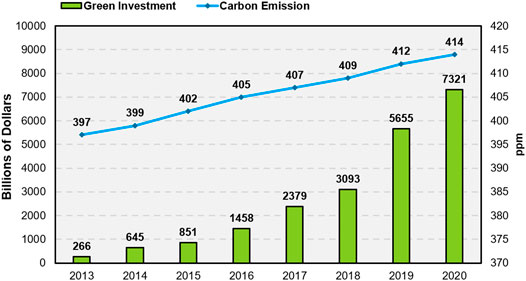
FIGURE 1. Global green investment and carbon emissions. The bar chart represents the amount of green investment (in billions of dollars). The line gragh represents the carbon emissions released into the atmosphere (in parts per million). Source: Bloomberg.
To avoid irreversible catastrophes, the United Nations Framework Convention on Climate Change (UNFCCC) was formed at the initiative of the United Nations. Parties organize meetings to evaluate the progress in addressing climate change issues. The Kyoto Protocol was agreed upon in 1997, prompting developed countries to meet their legal obligations to reduce greenhouse gas emissions. The Copenhagen Protocol, adopted in 2009, re-established the obligations of developed and developing countries to reduce emissions (Grubb et al., 2018). As the largest developing country, China is actively fulfilling its obligations to reduce its carbon emissions. At the 75th UN General Assembly, the Climate Ambition Summit, and the Central Economic Work Conference, President Xi Jinping of China made important commitments that China will strive to reach carbon peak by 2030 and achieve carbon neutrality by 2060. Meanwhile, the Chinese government has also introduced a series of policies to promote the implementation of carbon emission reduction. For example, in January and March 2021, the release of the Measures for the Administration of Carbon Emissions Trading (in Trial) and the Corporate Greenhouse Gas Emission Reporting Guidelines (in Trial) marked the official start of China’s carbon market. These policy documents also provided a basis for the verification of greenhouse gas emissions.
As an important investment and financing tool, green finance is defined differently in different countries. The European Commission considered it to be a financial instrument for supporting the combination of climate change mitigation, adaptation, and other green dimensions (Walter et al., 2017). In contrast, the People’s Bank of China (PBOC) defined it as a set of institutional arrangements and policies to facilitate the transfer of private capital to green sectors through financial services (Pan et al., 2015). Overall, green finance takes various forms, such as green bonds, green credit, green funds, and carbon finance, providing important guarantees for addressing climate change, and it can effectively allocate resources to green development projects (Eyraud et al., 2013; Kamra and Grover, 2021). According to a report by the United Nations Intergovernmental Panel on Climate Change (IPCC), to control global warming within 1.5°C, the average investment in the energy system should be between $1.6 trillion and $3.8 trillion between 2016 and 2050 (de Coninck et al., 2018). Globally, the scale of green finance invested in climate change mitigation projects has increased rapidly in recent years (Figure 1), but it is still far from the target set by the IPCC. Consequently, the international community is striving to take more effective measures to increase green finance investments for climate change mitigation and adaptation.
Several countries or organizations have played pivotal roles in green finance and cooperation in green finance. In 2016, the G20 included green finance as an issue to strengthen cooperation among national financial institutions. The European Commission has adopted a package of sustainable finance policies to provide companies with an integrated and sustainable framework to ensure financial transformation while avoiding greenwashing. For instance, the Proposal for a Corporate Sustainability Reporting Directive (CSRD) extends the types of companies that must disclose sustainability information to include all large and listed companies. The EU Taxonomy Climate Delegated Act specifies what green activities can contribute to meeting environmental goals and encourages companies to start new projects or upgrade existing projects. In the United States, with the election of a new president, the United States government is committed to tackling the problem of climate change problem. In January 2021, President Bidon announced that the United States is re-joining the Paris Agreement, after having been withdrawn from the Agreement by President Trump. The United States government has also launched a $2.3 trillion infrastructure proposal to make intensive investments in projects targeting, for example, the country’s transportation, energy and power systems (Tollefson, 2021).
China is also actively promoting the vigorous development of green finance. In 2016, the PBOC issued the Guidelines for Establishing the Green Financial System, providing a top-level design for the development of green finance in China. In June 2017, the Chinese state designated five provinces, namely, Zhejiang, Jiangxi, Guangdong, Guizhou and Xinjiang, in which to build green finance pilot zones. In March 2019, the National Development and Reform Commission, together with seven ministries and commissions, issued the Green Industry Guidance Catalogue (2019 Edition) to set industry standards. In February 2021, the Guiding Opinions on Accelerating the Establishment of a Sound Green, Low-Carbon and Circular Development Economic System were issued by the State Council of China. Subsequently, China’s first green finance regulation, the Shenzhen Special Economic Zone Green Finance Regulations, came into effect in March 2021, providing a guarantee to promote the regulation of green finance and to guide the orderly development of related institutions.
Against the backdrop above, recent studies on green finance and carbon emission reduction have been conducted. Such studies involve aspects such as the performance of green finance, risk assessment, and carbon emission reduction policy design. Therefore, a systematic review of the existing field is needed. Several bibliometric analyses on carbon emission reduction have been conducted. For instance, Zhang and Liang reviewed cooperation on carbon emission reduction (Zhang and Liang, 2020), and Huang et al. identified empirical methods of modelling Chinese sectoral carbon emissions (Huang et al., 2019). Additionally, the literature has focused on climate-related financial tools, such as the carbon market (Zhou and Li, 2019; Tang et al., 2020), carbon tax (Zhang et al., 2016), and green supply chains (Zhou et al., 2021). Nevertheless, a limited number of articles take a broader perspective to focus on green finance. Although some studies mention green finance (Cai and Guo, 2021; Cunha et al., 2021), they do not investigate the specific combination of green finance and carbon emission reduction. Therefore, we comprehensively review the recent literature on green finance and carbon emission reduction in the Web of Science core database. The following research objectives will be addressed by this article:
RQ1: What is the trend in the number of publications in the research field?
RQ2: What are the predominant countries, institutions, journals, research areas, and authors in the current field of research?
RQ3: What is the state of cooperation between authors and countries?
RQ4: What are the primary research priorities at the moment, and how have they changed over time?
RQ5: What research topics and references were highlighted at certain points in time?
RQ6: What are the main research directions in the current field?
By addressing the questions above, we will have an insight to the performance (RQ1-RQ3), progress (RQ4-RQ5), directions, challenges as well as future research (RQ6) of green finance and carbon emission reduction.(Lim et al., 2022).
The remainder of the paper is organized as follows: Section 2 introduces the methodology of the bibliometric analysis and search criteria. Section 3 presents the findings of the analysis, including the number of annual publications, major areas and institutions, publishing journals and research areas, authors, and keywords. Section 4 summarizes the research topic in DPSIR framework. Lastly, Section 5 draws our conclusion and policy implication.
2 Methodology
Bibliometric analysis, which is a quantitative way of discovering and evaluating articles in the corresponding research field, has seen a marked growth in use over the last two decades.(Zupic and Čater, 2015). Due to the complexity of the environmental issues, research might be conducted in an interdisciplinary approach, with the collaboration of universities, laboratories, non-governmental organizations, and financial institutions. As a result, compared with narrative literature evaluation, bibliometric analysis avoids the subjectivity of authors and incompleteness of contents, both of which are driven by the huge and intricate articles in the corresponding research field.(Donthu et al., 2021; Mukherjee et al., 2022). Moreover, the science mapping tools help to illustrate the cooperation, trends, and hotspots in a certain period of time, thus they can be presented in a more visualized way.(Romanelli et al., 2021). Consequently, by utilizing the bibliometric analysis approach in environmental scenarios, researchers will have a holistic view of the corresponding area, and it is also substantially significant to the development of environmental science.
To perform the bibliometric analysis, we used CiteSpace software developed by Prof. Chaomei Chen of Drexel University and visualization technology to construct a scientific map of the literature. Consequently, we can gain an in-depth understanding of the hotspots, correlations, development directions and trends of the field of study (Chen, 2004). Meanwhile, this software has been used in various bibliometric analysis studies (Ouyang et al., 2018; Su et al., 2019; Ye et al., 2020), indicating that it can support our research.
To ensure the quality of the literature, the Science Citation Index Expanded (SCI-EXPANDED) and Social Sciences Citation Index (SSCI) from the Web of Science core database were selected for the search. Since there were very few studies on related topics in the database before 2010, the time range of the selected literature in our work was 2010, 2021, and the endpoint was August 2021.
Based on the research field, we determined the search criteria, including “carbon”, “carbon dioxide”, “green finance”, “carbon finance”, “sustainable finance”, “climate finance”, “green credit”, “green venture capital”, “green bond”, and “green security”. The search string is as follows:
TS = ((“carbon” OR “CO2” OR “carbon dioxide”) AND (“green financ*” OR “carbon financ*” OR “sustainable financ*” OR “climate financ*” OR “green credit” OR “green venture capital” OR “green investment*” OR “green bond*” OR “green securit*”))
Finally, we performed the Preferred Reporting Items for Systematic Reviews and Meta-Analyses (PRISMA) (Moher, 2009) to exclude unqualified articles (Figure 2). After careful screening, we obtained 445 papers for the following analysis.
3 Research Overview
3.1 Number of Annual Publications
Analysing the temporal trend of the literature (Figure 3), we see that the number of articles has undergone two main phases: the first phase was from 2011 to 2018. During this period, the number of articles published was small, and the growth was slow, with 17 articles in 2011 and 40 articles in 2018. The second phase was from 2018 to 2020. During this period, the number of articles published increased rapidly, from 40 in 2018 to 92 in 2020. This increase was mainly because after 2019, more than 190 countries clearly defined and implemented their nationally determined contribution (NDC) targets to reflect their determination to address climate change, attracting the attention of scholars. The number of papers published in the first 8 months of 2021 was 73, and we expect that the total number will be higher than the number of papers published in 2020, reflecting an upward trend into the future.
3.2 Major Areas and Institutions
Figure 4 shows the distribution of countries with the highest number of publications. Of the top 10 countries, 8 are developed countries. Developed countries have higher levels of economic development, more advanced technology, and better research conditions; thus, they pay more attention to the development of the theory and practice of green finance. As developing countries, China and India are both large countries in terms of their population and economy. Meanwhile, environmental problems are also prominent. As a result, there is a greater emphasis on the development of green finance theory and practice in those countries.
The research cooperation between different countries is illustrated in Figure 5, which shows the collaborations between countries on the themes of green finance and the carbon emission reduction. The links indicate the collaborations between different countries, while the colours of the links indicate the dates of the collaborations. The results indicate that China, the United States, and the United Kingdom published the highest number of papers. The United Kingdom, the United States, and Canada produced studies earlier, while China, Germany, and Australia produced studies later. Additionally, the purple outer ring indicates the centrality of countries, and countries with a higher centrality have a wider outer ring. Of the top countries, the United States, the United Kingdom, China, France, Switzerland, and the Netherlands are the countries with the highest centrality.
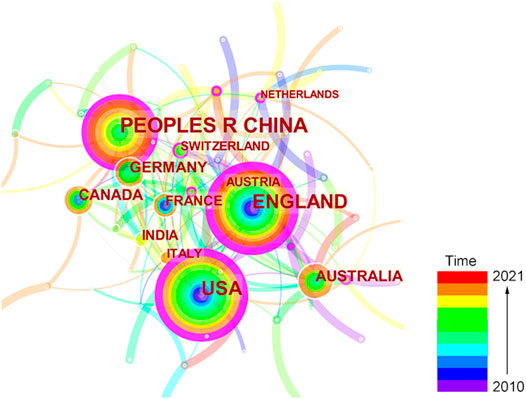
FIGURE 5. Network map of countries publishing papers. The links indicates cooperation between the related countries, and the colours represent the dates of the cooperation. The size of a circle is proportional to the number of studies contributed by countries or regions.
The top 10 most productive institutions are presented in Table 1. The institution with the largest number of publications is Oxford University in the United Kingdom, which has published 9 high-quality related articles. Overall, most of the top 10 publishing institutions are from developed countries such as the United Kingdom, Canada, France, and Germany. However, institutions in China are also strengthening their research efforts, and of these institutions, Tsinghua University has performed the best.
Analysing countries and institutions, we divide the relevant research into the following aggregate areas. First, developed countries and regions such as the United States, Europe, and Australia, which have great economic strength and where the financial industry developed early, coupled with more well-established research institutes, started publishing related works earlier, and the number of publications is also higher. Second, developing countries such as China and India focus on the construction of infrastructure. Both of them demand to solve the corresponding environmental problems; consequently, they need a large amount of funds to implement green projects. Finally, developing regions with vast forest resources, such as South Asia and South America, have sinks that can store significant amounts of carbon. The United Nations launched the Reducing Greenhouse Gas Emissions from Deforestation and Forest Degradation in Developing Nations (REDD+) initiative to fund countries that actively promote sustainable development and expand their forest carbon sinks (Fahey et al., 2010). As a result, numerous studies have been conducted on the carbon reduction and economic benefits of REDD + projects (Fuss et al., 2011; Nunes et al., 2012).
3.3 Publishing Journals and Research Areas
Figure 6 depicts the 10 journals and research fields that produced the most articles. Climate Policy (34 articles) contributes the most, followed by the Journal of Cleaner Production (27 articles) and Energy Policy (18 articles). Most articles involve the following research areas: ecological and environmental sciences (237 articles), followed by business and economics (80 articles), other subjects in science and technology (72 articles), energy and fuels (42 articles), engineering (39 articles), and public administration (38 articles).
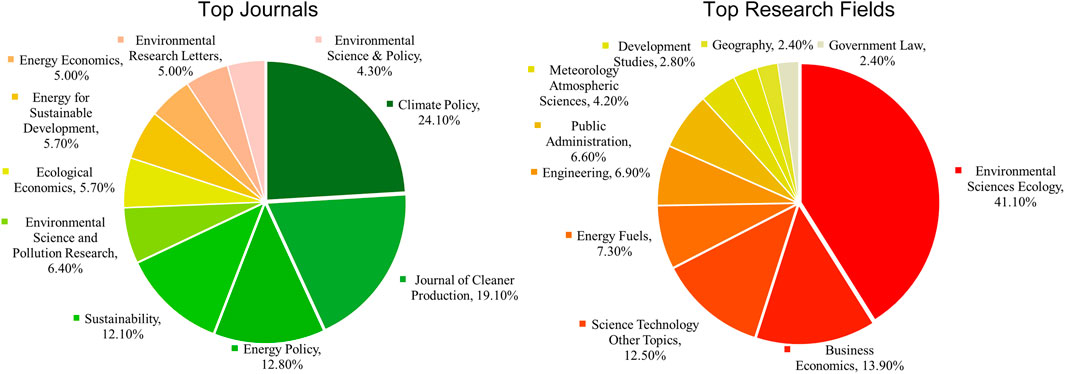
FIGURE 6. Productive journals and research fields. A single article can be categorized under several research directions.
3.4 Authors of the Publications
Table 2 lists the top 10 most productive authors. Among them, Professor Monasterolo Irene of the Vienna University of Economics and Business published the most articles. Her research directions are related to climate stress testing, the evaluation of climate risk and financial risk, and the EIRIN stock-flow consistent behavioural model. Her publications have appeared in Nature Climate Change, Environmental Science & Policy, Ecological Economics, and other journals (Pasqualino et al., 2015; Howarth and Monasterolo, 2016, 2017; Battiston et al., 2017; Monasterolo et al., 2017, 2018; Monasterolo and Raberto, 2018, 2019; Monasterolo and de Angelis, 2020), and the most influential article has gained 307 citations.
We investigated 1-year time slices of authors who published articles between 2010 and 2021 and visualized the cooperation network among the authors. Figure 7 demonstrates that collaborations occur mostly in pairs; additionally, groups of three or more collaborators are relatively rare. In general, the network density of collaborating authors is 0.0066, indicating that the majority of researchers prefer to conduct research individually (Tang et al., 2020).
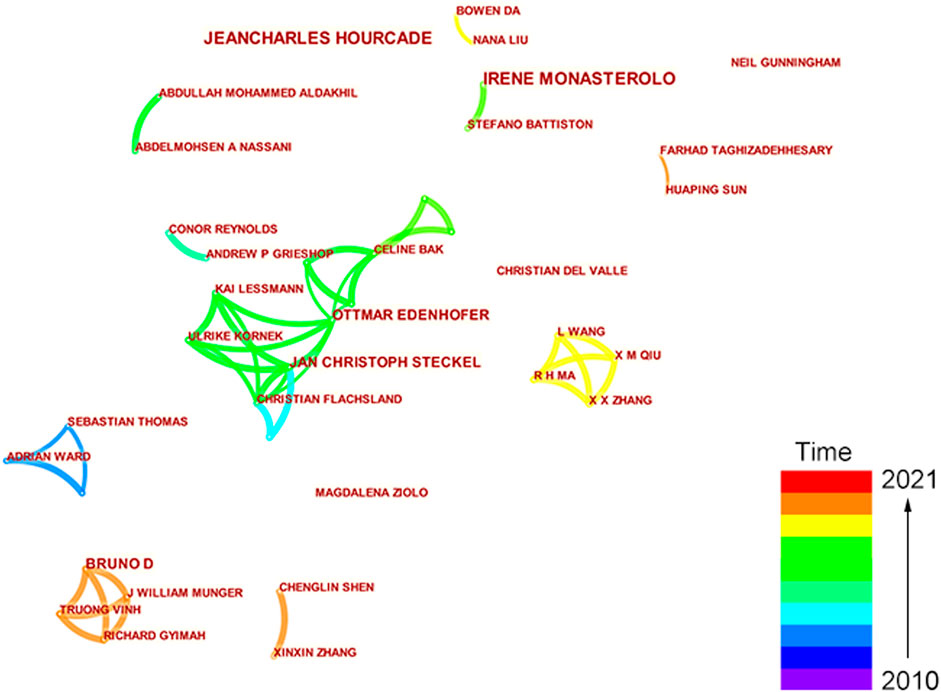
FIGURE 7. Cooperation network of different authors. The links indicate the cooperation of related authors, and the colours represent the dates of the cooperation.
3.5 Keyword Analysis
Figure 8 shows the frequency of keywords. The most frequent keyword is “climate change”, followed by “policy”, “climate finance”, “CO2 emission”, “impact”, “economic growth”, “China”, “energy”, “carbon finance”, “carbon”, and “carbon market”.
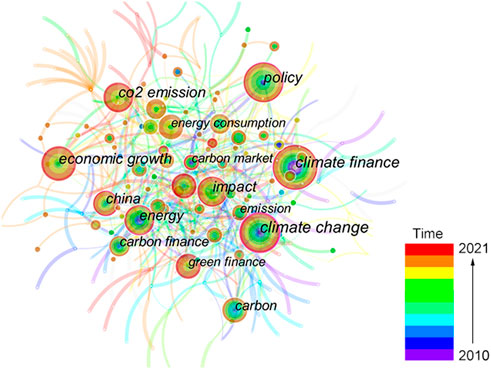
FIGURE 8. Network of keywords by frequency. The links indicate the connections of related keywords, and the colours represent the dates of the connections. The size of a circle is proportional to the frequency of the keywords.
The centrality of a node represents the node’s connection with other nodes; the higher the centrality is, the greater the importance of the node’s participation in the network. As shown in Figure 9, the keyword with the highest centrality is also “climate change”, other keywords are “policy”, “energy”, “long-term”, “challenge”, “impact”, and “model".
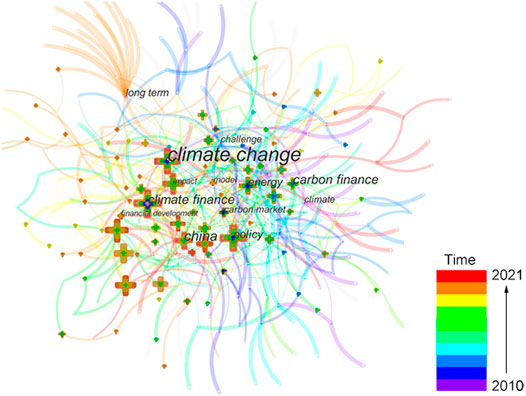
FIGURE 9. Network of keywords by centrality. The links indicate the connections of related keywords, and the colours represent the dates of the connections. The size of the cross icon is proportional to the centrality of the keywords.
Figure 10 further shows the temporal evolution of keywords between 2011 and 2021. The high-frequency keywords in the early research direction (2011–2013) were mainly “climate change”, “climate finance”, “carbon finance”, “China”, “policy”, and “energy”. In the following 3 years (2014–2017), the high-frequency keywords were “emission”, “conservation”, “market”, “economic growth”, and “performance”. The main keywords in recent years (2018–2021) were “renewable energy”, “CO2 emission”, " energy consumption”, “green finance”, and “green bond”. In short, the research direction has shifted over the last decade from exploring the related policy design to exploring the efficiency and environmental protection effect of green finance. Additionally, with the emergence of new energy sources and financing mechanisms such as green bonds and green credits in the last few years, the research direction has updated to reflect these developments.
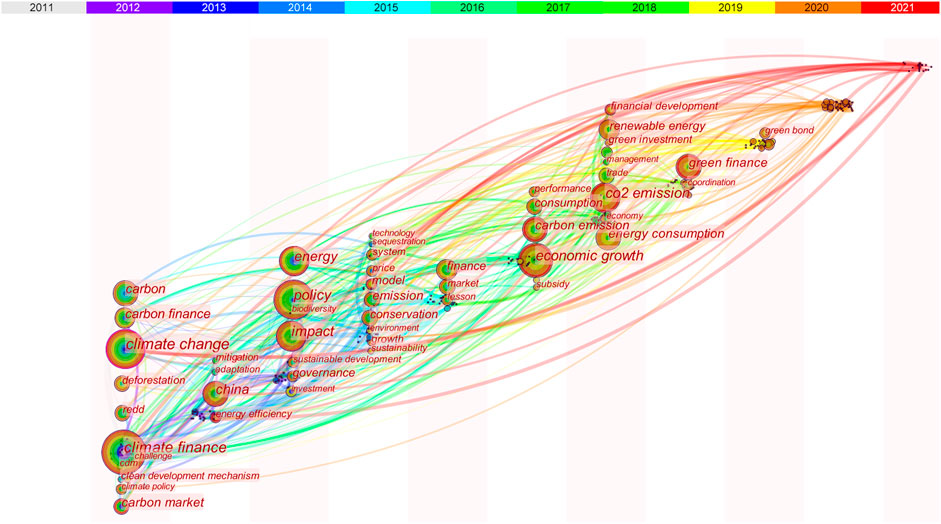
FIGURE 10. Temporal evolution of keywords from 2011 to 2021. The links refer to the connection of related keywords, the colour of which represents the time of connection. The size of a circle is proportional to the frequency of keywords.
3.6 High Burstiness of Keywords and References
Burstiness refers to a surge in keywords or cited studies over a specified time period, indicating that they draw widespread attention from the research field during that time period. Thus, burstiness detection is useful for determining the degree to which keywords or articles in this field are at the frontier of research. As a result, this study examines the burstiness of keywords and referenced studies.
3.6.1 High Burstiness of Keywords
Figure 11 shows the keywords with high burstiness. From 2011 to 2021, in chronological order, they are “carbon finance”, “clean development mechanism”, “adaptation”, “carbon sequestration”, “stock”, “carbon market”, “sequestration”, “conservation”, “governance”, “emission”, “mitigation”, “trade”, “political economy”, “management”, “CO2 emission”, “green finance”, and “green bond”. The keywords with a longer burstiness (lasting for more than 3 years) are “clean development mechanism” (2011–2015), “adaptation” (2012–2016), “carbon market” (2013–2017), and “sequestration” (2014–2017). These results indicate that these keywords are typically topics of high interest for a long period. Currently, “CO2 emission”, “green finance”, and “green bond” are becoming more popular, as they appeared in 2019 and had lasted into the present.
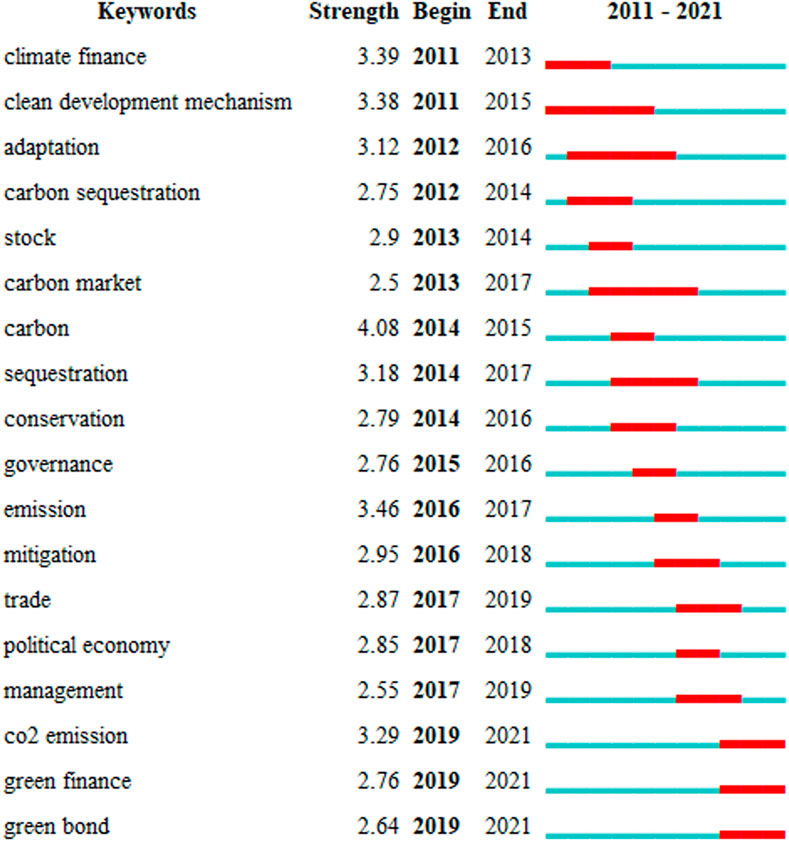
FIGURE 11. High burstiness of keywords. The green line represents the period during which the keyword appeared, and the red line indicates the period during which the keyword received wide attention.
3.6.2 High Burstiness of Publications
A thorough examination of the literature based on its high emergence in the relevant years helps summarize the research hotspots in different periods (Figure 12). The following literature is utilized in this study to demonstrate the hotspots of research.

FIGURE 12. High burstiness of references. The green line represents the period during which the reference appeared, and the red line indicates the period during which the reference received wide attention.
Pendleton et al. (Pendleton et al., 2012) focus on blue carbon research. Most of the literature studies the reduced carbon sequestration capacity of coastal vegetation ecosystems due to their destruction, while little literature has considered that these vegetated environments (i.e., sediments such as silt) also have sinks that can store large amounts of carbon that is released into the atmosphere with the destruction of coastal vegetation ecosystems, resulting in increased greenhouse gas concentrations. This article is the first to measure the global storage of blue carbon and to estimate the economic impact of releasing these sinks into the atmosphere; thus, it contributes to the establishment of carbon accounting and carbon markets.
Stadelmann et al. (Stadelmann et al., 2013) focus on the accounting of private capital in addressing climate change. According to the Copenhagen and Cancun Agreements, developed countries mobilized $100 billion per year in public and private finance for developing countries through 2020. Most of the existing literature has studied public finance, but research on private finance is limited. The article summarizes the different ways of financing private capital and analyses their quality.
Lee and Min (Lee and Min, 2015) examine the relationship between environmental innovation and firm performance from the firm perspective. A consensus on the relationship between environmental innovation and business performance has yet to be reached. Consequently, additional research about the impact of eco-innovation on company performance is required. This article investigates the relationship between green research and development (R&D) investment and carbon emissions and financial performance.
Wang and Zhi (Wang and Zhi, 2016) demonstrate the status of green finance. First, they summarized the market mechanism of green finance and green finance products, which play an indispensable role in adjusting the scale, speed and structure of economic development through the leverage effect. The article also proposes that policy is important for raising funds for environmental protection industries, whose payback period is long. It suggests that in the future, innovation and development should focus on both financial tools and fiscal revenue management.
Battiston (Battiston et al., 2017) concentrate on the financial concerns associated with climate change. While a number of climate measures have been implemented to achieve the 2°C global temperature target, the question of whether these policies will result in systemic hazards in the financial sector has generated much debate. This paper establishes a framework for conducting climate stress tests, evaluates how risks associated with climate policies are transmitted via the financial sector, and assesses the impact of policy risks on large financial institutions.
Monasterolo and Raberto (Monasterolo and Raberto, 2018) examine the role of monetary policy, fiscal policy, and financial instruments in the design of climate change responses. They find that there is a high level of uncertainty in the analysis results because a comprehensive understanding of the direct and indirect effects of the real economy and financial markets is lacking. Consequently, they create a set of EIRIN models and illustrate the influence of business investments in brown and green sectors on unemployment, credit and bond markets, and other variables.
Campiglio et al. (Campiglio et al., 2018) take the broader view of central banks and associated regulators on climate change and the low-carbon transition. They point out that central banks and regulators should evaluate climate-related financial risks, as climate change that is not mitigated will potentially influence financial stability. Moreover, they argue that future research should focus on developing effective methods and collecting data to assess climate change risks, as well as models for evaluating the impact of climate-related risk on the macroeconomy and society.
4 Research Topics Classification in the DPSIR Framework
The Driving-Pressure-State-Impact-Response (DPSIR) model is generally used to construct a conceptual framework of the interaction between environment and society (Wei et al., 2019). In order to present a holistic view of the research topic, we carefully review and then classify the related articles in DPSIR framework. The logical relationship is illustrated in Figure 13.
4.1 Driving Forces
The implementation of green finance at the regional scale is motivated by the need for regional sustainable development, and it is promoted by appropriate economic policies. Several studies have examined the processes through which macro- and microeconomic policies related to climate change affect green financing. Public finance, taxes, Clean Development Mechanism (CDM) financing, and private cost financing are common policy mechanisms that have varying implications for the growth of green finance (Bowen, 2011; Aglietta et al., 2015; Zhang et al., 2021). As a new green financing technique, carbon tax has an influence on the profitability and environmental performance of supply chains, making it possible to identify the optimal strategic investment decisions under each tax model (Chelly et al., 2021). Feed-in-tariff (FIT) and carbon pricing policies benefit green investments (Eyraud et al., 2013). Some studies also consider more factors, such as politics, the economy and culture, in promoting green finance (Du et al., 2019; Nawaz et al., 2021). However, Xu et al. (Xu et al., 2017) take sectoral panel analysis in China and find that climate policies have favourable effect on investments in transportation sector, but have no effect on biofuel, agriculture, or building sectors. Cojoianu et al. (Cojoianu et al., 2020) argue that FIT policies have a negative impact on the new entry of grey and brown funds.
4.2 Pressure
Ignoring climate risks when setting financial policies may undermine their effectiveness. The uncertainty of climate change can weaken the performance of financial policies (Bhandary et al., 2021). For example, infrastructures that are vulnerable to climate change may perform poorly in the long term, resulting in feeble investment (Reynolds et al., 2020). Additionally, the risk of climate change is of greater concern to institutional investors, and they need assurances that their portfolios will not be affected by this potential risk (Bender et al., 2019). A limited number of studies have made mention of the dimensions above (Clapp and Prag, 2012). D’Orazio and Popoyan (D’Orazio and Popoyan, 2019) suggest that greater capital requirements should be imposed on banks with brown assets to mitigate the risk of expanding green financing. Future research should incorporate climate factors when assessing the effectiveness of green finance projects and policies and quantitively analyse the risk from the business perspective.
4.3 State
Driven by policy and climate risk, many countries or institutions in the world are exploring the mechanism of green finance to mitigate carbon emission and adapt to climate change. At present, countries or institutions have implemented various green taxonomic practices to classify green assets. First, the International Organization for Standardization (ISO) established a technical committee (ISO/TC 322) to support the United Nations Sustainable Development Goals (SDGs). One of the committee’s objectives is to standardize the principles, terminology, and assessment of green finance, and several standards are under development, including ISO 32210, ISO 32220, and ISO 14100. Second, the European Union Commission published the first EU sustainable plan in March 2018, i.e., Action Plan: Financing Sustainable Growth, and then established a Technical Expert Group on Sustainable Finance (TEG) in May 2018. The final report on the EU taxonomy and Technical Annex were released in March 2020 to provide technical guidance on the green taxonomy. Third, seven ministries of the Chinese government published the Guiding Opinions on the Green Financial System in August 2016, which laid the foundation for the green taxonomy in China (Peng et al., 2018). In addition, the PBOC issued the first Chinese green finance standards, i.e., the Guidelines on Environmental Information Disclosure for Financial Institutions (JR/T 0227–2021) and Environmental Equity Financing Tool (JR/T 0228–2021), contributing to the classification of environmental equity financing instruments and green investment procedures. However, inconsistent definitions and a taxonomy of green finance potentially have a negative influence on the international cooperation of green projects, making it difficult to guide public and private investment in all green properties; moreover, it increases the potential of international greenwashing behaviour resulting from asymmetric information (Rado, 2019). Therefore, a unified green definition, along with a taxonomy, is needed for investors to identify adequate green properties.
As a growing financing tool that can assist in climate change mitigation and adaptation, green bonds have recently grown rapidly. They can successfully fund low-carbon infrastructure while mitigating and adapting to climate risks (Sartzetakis, 2020). External assessment can increase the transparency of green bonds and their capacity for emission reduction (Fatica and Panzica, 2021). In addition, some papers focus on the green bond market, including mechanisms (Reboredo, 2018; Lee et al., 2021; MacAskill et al., 2021), connectedness with conventional markets (Broadstock and Cheng, 2019; Dutta et al., 2020; Reboredo and Ugolini, 2020; Yahya et al., 2020; Gao et al., 2021; Pham, 2021), and investor attention (Nanayakkara and Colombage, 2019; Pham and Huynh, 2020; Piñeiro-Chousa et al., 2021). Despite Sinha et al. (Sinha et al., 2021) investigated the impact green bonds on social responsibility and environment at a global scenario, studies assessing the effectiveness of green bonds in carbon emission reduction and environment are still limited. This situation can be explained by inconsistent standards and non-transparent information (Gibon et al., 2020).
4.4 Impact
The impact of green finance can be reflected in CO2 emission reduction. Le et al. (Le et al., 2020) took the perspective of financial inclusion and concluded that the development of inclusive finance will result in a reduction in CO2 emissions. Nevertheless, Zahan and Chuanmin (Zahan and Chuanmin, 2021) argue that green investment reduces carbon emissions in the long run and that the increased consumption of clean energy can have an environmental improvement effect. Additionally, high CO2 emissions might have a detrimental influence on business financial indicators at the micro level (Xu et al., 2020).
Moreover, the impact also conveys in other aspects. Green investment contributes to a rational redistribution of income, which provides benefits by increasing employment levels (Banacloche et al., 2020), social welfare (Glomsrød and Wei, 2018), and GDP growth (Glomsrød and Wei, 2018; Banacloche et al., 2020). Studies have examined this relationship using quantitative methods at the national, regional and industry levels. Some researchers focus on the energy, environmental, and economic perspectives (Ahmed et al., 2018; Cosmas et al., 2019; Wang et al., 2020; Ziolo et al., 2020; Gustafsson et al., 2022), while others introduce more influences, including industrial added value (Batrancea et al., 2020), private sector and foreign investment, population, R&D, the human development index (HDI) (Baek, 2016; Nawaz et al., 2021), and political issues (Du et al., 2019).
4.5 Response
There are two broad financing mechanisms to reduce carbon dioxide emissions. One is carbon markets using market mechanisms; another is funding for carbon sequestration projects in developing countries, called REDD + Programme.
4.5.1 Carbon Market
Carbon markets are a means for the UNFCCC to address climate change using market mechanisms (Michaelowa et al., 2019). The steady growth of the carbon trading market requires a solid pricing mechanism, and natural gas prices, oil prices, and natural gas and coal conversion prices all have a significant influence on the carbon price (Boersen and Scholtens, 2014; Elie et al., 2019; Dutta et al., 2021; Yahya et al., 2021). Some references investigated the volatility of carbon prices and the linkage between carbon prices and energy prices in phases I, II and III of the European Union (EU) Emissions Trading Scheme (ETS) (Gebara, 2013; Boersen and Scholtens, 2014; Michaelowa et al., 2019) as well as China’s National (CN) ETS plots (Chang et al., 2019). Moreover, many studies discuss dilemmas associated with carbon markets, including market volatility as a result of structural and political issues (Yu et al., 2015), the inefficiency of the carbon price as a result of market failure (Ji et al., 2018), debt and power distribution issues (Chevallier, 2009), and the clash with the environment (Chu et al., 2020). Consequently, the development of carbon markets requires a concerted effort on the part of all stakeholders to normalize financial processes (Chang et al., 2019).
Quantitative models are commonly used to assist governments in advancing market mechanisms and corporations in developing plans (Tang et al., 2020). A considerable number of models have been adopted for carbon market research, including optimization models (Yoshino et al., 2010; Jiang et al., 2016), simulation models (Lin and Jia, 2018), statistical models (Chang et al., 2017; Liu et al., 2018), and assessment models (Zhang et al., 2017). In addition, coupling different models can optimize the related studies. For example, Tang et al. (Tang et al., 2020) mention that the integration of artificial intelligence (AI) models and statistical models can improve the accuracy of the interpretability of carbon market research. Chai et al. and Chen et al.(Chai et al., 2020; Chen et al., 2021) use support vector machine (SVM) and particle swarm optimization (PSO) techniques, respectively, to forecast carbon prices, helping investors and risk managers in their decision-making. Therefore, future research should balance adequate models for carbon market-related research.
Furthermore, research on CN ETS will be a potential topic. In July 2021, China officially launched its carbon trading market after the 10-years pilots in seven provinces. The market is initially focusing on the electric power industry, and the time at which other sectors are incorporated in what order should be considered (Karplus, 2021). One of the key characteristics of the carbon market is the carbon emission allowance, which limits the annual carbon emissions of a corporation. How to incorporate fairness (Wiedenhofer et al., 2017), efficiency (Wu et al., 2020), and uncertainty (Ye et al., 2017; O’ Ryan et al., 2019) into the allocation holds significance for the carbon market. Another dimension of CN ETS is the policy design. From the perspective of global practices, carbon market policies usually evolve from simple to complex and from flexible to strict. As CN ETS is in its initial stage, the government should learn from the world’s advanced practices and explore adequate policies that suit China’s national conditions, including carbon pricing, transactions, performance assessments, etc.
4.5.2 REDD + Programme
Forests are the greatest carbon sinks in terrestrial ecosystems, and their protection can help lower greenhouse gas concentrations in the atmosphere and moderate global warming. During the 11th Conference of the Parties to the United Nations Framework Convention on Climate Change (COP11) in 2005, REDD + projects started. In relation to donee countries, developing areas are compensated for reducing deforestation and forest degradation through REDD + projects (Norman and Nakhooda, 2015; Turnhout et al., 2017). As one of the most significant carbon sink projects in the world, numerous studies verifying the forest carbon stocks in various locations and analysing the costs and benefits of projects have been carried out (Peskett et al., 2011; Graham et al., 2016). For example, Ravikumar et al. (Ravikumar et al., 2017) estimated the benefits of carbon financing under various land use scenarios in Peru, Indonesia, Tanzania, and Mexico. On the other hand, as for donor countries, both the public (e.g., United Nations Development Programme (UNDP), Food and Agriculture Organization (FAO)) and private (e.g., local REDD + initiatives) sectors can be sources of financing for REDD+ (Parker et al., 2009). The private sector is gradually playing a more imperative role in REDD+, and it is predicted to provide more funding than the public sector in the future (Miah and Aturo, 2021). Carbon transfer payments are one of the methods for distributing private funds, but the selling price of carbon offsets is low and unstable because of the voluntary market (Meza et al., 2021). This situation results in a small share of carbon transfer payments. Simonet et al. (Simonet et al., 2014) investigated 410 global REDD + projects and found that only 16% of funding comes from carbon offset transactions. Another issue is the unequal distribution of funds and benefits (Gebara, 2013; Guerra and Moutinho, 2020). Therefore, future research should pay attention to the transmission pathways underlying the effect of deforestation, as well as quantitative evaluation methods for examining the fairness and effectiveness of REDD + policy implementation.
REDD + plays an important part in carbon emission reduction and biodiversity enhancement. The community forest programmes in Guatemala’s Mayan Biosphere Reserve (MBR) have been found to offset approximately 1 million tons of CO2 equivalent per year (Hodgdon et al., 2013), while the Norway-Guyana REDD + project successfully decreased deforestation by 35%, averting 12.8 million tons of CO2 emissions (Roopsind et al., 2019). Abram et al. (Abram et al., 2016) examined the financial feasibility of converting common forest trees to oil palm in Malaysia and discovered that the cost of reducing emissions ranged between $9 and $75 per ton. Most researchers believe that carbon funding will benefit forest initiatives. More importantly, the REDD + projects have a number of significant benefits, including ecosystem services and biodiversity enhancement. (Jantz et al., 2014). The multiple effects of REDD + need to be examined (Alusiola et al., 2021). The decrease in agricultural land will raise the price of crops, exacerbating food scarcity (Huettner, 2012; Loaiza et al., 2015). Meanwhile, REDD + tends to change the previous rules of community forests and does not accommodate changes in the local social and economic environment (Hajjar et al., 2021). Future research should concentrate on the impact of REDD + on community forests and how to prioritize community forests (Bayrak and Marafa, 2016).
5 Conclusion
Green finance provides an important supporting tool for carbon emission reduction or other green projects, and the sustainable ecological and environmental development has become an indispensable target of green finance. Our study takes green finance and carbon emission reduction as its theme and searches for literature in the Web of Science core database to conduct a bibliometric analysis of studies published between 2011 and 2021. We summarize the status, trends and hotspots of the related research and clarify the challenges and future research, which will help to study green finance and carbon emission reduction in more depth. However, limitation exists where the articles selected for analysis are basically from WoS database, despite the quality of articles are guaranteed, the quantity of papers is relatively low. Different databases could be comprised to strengthen the representativeness of results. Moreover, besides using DPSIR framework in classifying the articles, it is also useful classify the articles characteristic based on methodological choices and research contexts, which can shed light on the trends of research characteristics and benefit the scholars working in the area (Kumar et al., 2022). Finally, the major conclusions of this study are as follow.
1) Between 2011 and 2018, there were a small number of related studies, growing from 17 in 2011 to 40 in 2018. Between 2018 and 2020, the number of studies increased considerably, from 57 in 2019 to 92 in 2020. We expect that the total number of studies in the future will be higher than the number of papers published in 2020.
2) Developed countries and regions such as North America, Europe, and Australia produced the most studies because of their great economic strength and well-established research institutes. Some developing countries, such as China and India, have made significant contributions to this field. Emerging regions, such as South Asia and South America, contain a significant quantity of forest carbon sinks and emphasize research supported through REDD + programmes. Moreover, the United Kingdom, the United States, and Canada published studies early, while China, Germany, and Australia published studies later. In terms of institutions, Oxford University published the largest number of papers, and most of the top institutions were from developed countries, while China also made contributions.
3) The top three journals in terms of the article count were Climate Policy, Journal of Cleaner Production, and Energy Policy, which together accounted for 21.9% of all papers. The top research area was ecological and environmental sciences, followed by business and economics, other topics in science and technology, energy and fuels, engineering, and public administration.
4) The collaboration analysis shows that the majority of academics cooperated with fewer than three authors. Professor Irene Monasterolo of the Vienna University of Economics and Business published the most articles in the field. Her research directions include climate stress testing, the evaluation of climate risk and financial risk, and the EIRIN stock-flow consistent behavioural model.
5) The keyword analysis finds that “climate change” had the greatest frequency and centrality. It was followed by keywords such as “policy”, “energy”, “impact”, “economic growth”, and “long-term”. The analysis of the temporal evolution of keywords demonstrates that the trend of research evolved from exploring policies to exploring the efficiency and environmental protection effect of green finance. Furthermore, the trend has updated with the emergence of new energy sources and financing mechanisms.
6) Burstiness can reflect the frontiers in a specified period. We find that “clean development mechanism”, “adaptation”, “carbon market”, and “sequestration” were typically high-interest topics for a long period. “CO2 emissions”, “green finance”, and “green bond” have become more popular, as they appeared in 2019 and continue into the present. The hotspots of references include global blue carbon estimation and impact, private capital for addressing climate change, and the current status and concerns of green finance.
7) The DPSIR framework is feasible and apprehensible in constructing a holistic picture of current research. We apply the framework in clustering articles about green finance and carbon emission reduction. We divide the articles into: driving forces, state, pressure, impact and response, and identify current research topic, limitations and future research.
Through the above analysis, the research on green finance and carbon emission reduction is gradually gaining the attention of the academic community, and the future research direction in this field might focus on the following issues: Incorporating climate factors into assessing the effectiveness of green finance projects and policies, quantitively analyse the risk from the business perspective; Constructing a unifying green definition and taxonomy in identifying green properties for investors; Balancing adequate models for carbon market-related research; Transmission pathways underlying the effect of deforestation; Quantitative evaluation methods for examining the fairness and effectiveness of REDD + policy implementation as well as the impact and priority level of community forests.
Meanwhile, the policy implication of this article is profound. Firstly, in the wake of the surging growth of green finance, the discrepancy of green standards between nations and sectors is apparent, leading to latent threats such as greenwashing behaviors, governments should communicate and collaborate with one another, and international organisations (such as the United Nations) could play a proactive role in encouraging the implementation of related policies to reconcile the green taxonomies globally. Secondly, the cooperation network of authors shows that a majority of researchers study separately, however, some environmental issues are in the position at the global level, particularly for carbon sequestration projects such as REDD+, which involves the participation of both donor and donee countries. In order to enhance mutual understanding and promote the development of green finance, more international projects are encouraged to be set up to boost the collaboration of researchers from different countries. Finally, with the establishment of carbon neutrality goals in numerous countries, emerging carbon markets continue to grow. In this scenario, governments should utilise fiscal and monetary measures to ensure that the emerging carbon market functions effectively, and the market mechanism is also required to stimulate vitality.
At present, the COVID-19 pandemic has caused a global economic crisis, and many countries are using green finance to revive their economy and move it towards sustainable development. Specifically, the EU 2021–2027 long-term budget coupled with Next Generation EU (NGEU) will provide a total of 2.018 trillion euros for green development and digital transformation. In addition, as an important country for the implementation of carbon emission reduction, China has used a range of financial instruments to reduce its carbon emissions, especially the recent national carbon emission trading market. We hope that our work provides a systematic review of green finance for carbon emission reduction to boost the research in this field, especially under the recovery from the COVID-19 pandemic and for the construction of sustainable societies.
Data Availability Statement
The raw data supporting the conclusion of this article will be made available by the authors, without undue reservation.
Author Contributions
ZZ: Writing-original draft, Methodology, Software and Data curation, Visualization. YL: Conceptualization, Supervision, Validation, Reviewing and Editing. ZH and XL: Formal analysis, Validation, Reviewing and Editing.
Funding
This work was supported by the National Natural Science Foundation of China (42071287), National College Students Innovation and Entrepreneurship Training Program of Shandong (S202110427038), College students Innovative Entrepreneurial Training Plan Program of University of Jinan (SXB20200050), as well as Construction of the peak discipline of applied economics (JNSX2021011).
Conflict of Interest
The authors declare that the research was conducted in the absence of any commercial or financial relationships that could be construed as a potential conflict of interest.
Publisher’s Note
All claims expressed in this article are solely those of the authors and do not necessarily represent those of their affiliated organizations, or those of the publisher, the editors and the reviewers. Any product that may be evaluated in this article, or claim that may be made by its manufacturer, is not guaranteed or endorsed by the publisher.
Acknowledgments
We are grateful for the support and assistance we received from Jianshu Lv. We thank the reviewers for their valuable comments and suggestions.
References
Abram, N. K., MacMillan, D. C., Xofis, P., Ancrenaz, M., Tzanopoulos, J., Ong, R., et al. (2016). Identifying Where REDD+ Financially Out-Competes Oil Palm in Floodplain Landscapes Using a Fine-Scale Approach. PLoS ONE 11, e0156481. doi:10.1371/journal.pone.0156481
Aglietta, M., Hourcade, J.-C., Jaeger, C., and Fabert, B. P. (2015). Financing Transition in an Adverse Context: Climate Finance beyond Carbon Finance. Int. Environ. Agreements 15, 403–420. doi:10.1007/s10784-015-9298-1
Alusiola, R. A., Schilling, J., and Klär, P. (2021). REDD+ Conflict: Understanding the Pathways Between Forest Projects and Social Conflict. Forests 12, 748. doi:10.3390/f12060748
Baek, J. (2016). A New Look at the FDI-Income-Energy-Environment Nexus: Dynamic Panel Data Analysis of ASEAN. Energy Policy 91, 22–27. doi:10.1016/j.enpol.2015.12.045
Banacloche, S., Cadarso, M. A., Monsalve, F., and Lechon, Y. (2020). Assessment of the Sustainability of Mexico Green Investments in the Road to Paris. Energy Policy 141, 111458. doi:10.1016/j.enpol.2020.111458
Batrancea, I., Batrancea, L., Maran Rathnaswamy, M., Tulai, H., Fatacean, G., and Rus, M.-I. (2020). Greening the Financial System in USA, Canada and Brazil: A Panel Data Analysis. Mathematics 8, 2217. doi:10.3390/math8122217
Battiston, S., Mandel, A., Monasterolo, I., Schütze, F., and Visentin, G. (2017). A Climate Stress-Test of the Financial System. Nat. Clim. Change 7, 283–288. doi:10.1038/nclimate3255
Bayrak, M., and Marafa, L. (2016). Ten Years of REDD+: A Critical Review of the Impact of REDD+ on Forest-Dependent Communities. Sustainability 8, 620. doi:10.3390/su8070620
Bender, J., Bridges, T. A., and Shah, K. (2019). Reinventing Climate Investing: Building Equity Portfolios for Climate Risk Mitigation and Adaptation. J. Sustain. Finance Invest. 9, 191–213. doi:10.1080/20430795.2019.1579512
Bhandary, R. R., Gallagher, K. S., and Zhang, F. (2021). Climate Finance Policy in Practice: A Review of the Evidence. Clim. Policy 21, 529–545. doi:10.1080/14693062.2020.1871313
Boersen, A., and Scholtens, B. (2014). The Relationship Between European Electricity Markets and Emission Allowance Futures Prices in Phase II of the EU (European Union) Emission Trading Scheme. Energy 74, 585–594. doi:10.1016/j.energy.2014.07.024
Bowen, A. (2011). Raising Climate Finance to Support Developing Country Action: Some Economic Considerations. Clim. Policy 11, 1020–1036. doi:10.1080/14693062.2011.582388
Broadstock, D. C., and Cheng, L. T. W. (2019). Time-Varying Relation Between Black and Green Bond Price Benchmarks: Macroeconomic Determinants for the First Decade. Finance Res. Lett. 29, 17–22. doi:10.1016/j.frl.2019.02.006
Cai, R., and Guo, J. (2021). Finance for the Environment: A Scientometrics Analysis of Green Finance. Mathematics 9, 1537. doi:10.3390/math9131537
Campiglio, E., Dafermos, Y., Monnin, P., Ryan-Collins, J., Schotten, G., and Tanaka, M. (2018). Climate Change Challenges for Central Banks and Financial Regulators. Nat. Clim. Change 8, 462–468. doi:10.1038/s41558-018-0175-0
Chai, S., Du, M., Chen, X., and Chu, W. (2020). A Hybrid Forecasting Model for Nonstationary and Nonlinear Time Series in the Stochastic Process of CO2 Emission Trading Price Fluctuation. Math. Problems Eng. 2020, 1–13. doi:10.1155/2020/8978504
Chang, K., Pei, P., Zhang, C., and Wu, X. (2017). Exploring the Price Dynamics of CO2 Emissions Allowances in China's Emissions Trading Scheme Pilots. Energy Econ. 67, 213–223. doi:10.1016/j.eneco.2017.07.006
Chang, K., Ye, Z., and Wang, W. (2019). Volatility Spillover Effect and Dynamic Correlation Between Regional Emissions Allowances and Fossil Energy Markets: New Evidence from China's Emissions Trading Scheme Pilots. Energy 185, 1314–1324. doi:10.1016/j.energy.2019.07.132
Chelly, A., Nouira, I., Hadj-Alouane, A. B., and Frein, Y. (2021). A Comparative Study of Progressive Carbon Taxation Strategies: Impact on Firms' Economic and Environmental Performances. Int. J. Prod. Res., 1–25. doi:10.1080/00207543.2021.1924410
Chen, C. (2004). Searching for Intellectual Turning Points: Progressive Knowledge Domain Visualization. Proc. Natl. Acad. Sci. U.S.A. 101, 5303–5310. doi:10.1073/pnas.0307513100
Chen, J., Ma, S., and Wu, Y. (2021). International Carbon Financial Market Prediction Using Particle Swarm Optimization and Support Vector Machine. J. Ambient. Intell. Hum. Comput. doi:10.1007/s12652-021-03240-7
Chevallier, J. (2009). Carbon Futures and Macroeconomic Risk Factors: A View from the EU ETS. Energy Econ. 31, 614–625. doi:10.1016/j.eneco.2009.02.008
Chu, W., Chai, S., Chen, X., and Du, M. (2020). Does the Impact of Carbon Price Determinants Change with the Different Quantiles of Carbon Prices? Evidence from China ETS Pilots. Sustainability 12, 5581. doi:10.3390/su12145581
Clapp, C., and Prag, A. (2012). Projecting Emissions Baselines for National Climate Policy. OECD/IEA Clim. Change Expert Group Pap. doi:10.1787/5k3tpsz58wvc-en
Cojoianu, T. F., Clark, G. L., Hoepner, A. G. F., Veneri, P., and Wójcik, D. (2020). Entrepreneurs for a Low Carbon World: How Environmental Knowledge and Policy Shape the Creation and Financing of Green Start-Ups. Res. Policy 49, 103988. doi:10.1016/j.respol.2020.103988
Cosmas, N. C., Chitedze, I., and Mourad, K. A. (2019). An Econometric Analysis of the Macroeconomic Determinants of Carbon Dioxide Emissions in Nigeria. Sci. Total Environ. 675, 313–324. doi:10.1016/j.scitotenv.2019.04.188
Cunha, F. A. F. d. S., Meira, E., and Orsato, R. J. (2021). Sustainable Finance and Investment: Review and Research Agenda. Bus. Strat. Env. 30, 3821–3838. doi:10.1002/bse.2842
de Coninck, H., Revi, A., Babiker, M., Bertoldi, P., Buckeridge, M., Cartwright, A., et al. (2018). “Strengthening and Implementing the Global Response,” in Global Warming of 1.5° C: Summary For Policy Makers (IPCC-The Intergovernmental Panel on Climate Change), 313–443.
Diffenbaugh, N. S., and Burke, M. (2019). Global Warming Has Increased Global Economic Inequality. Proc. Natl. Acad. Sci. U.S.A. 116, 9808–9813. doi:10.1073/pnas.1816020116
Diffenbaugh, N. S., Singh, D., Mankin, J. S., Horton, D. E., Swain, D. L., Touma, D., et al. (2017). Quantifying the Influence of Global Warming on Unprecedented Extreme Climate Events. Proc. Natl. Acad. Sci. U.S.A. 114, 4881–4886. doi:10.1073/pnas.1618082114
Donthu, N., Kumar, S., Mukherjee, D., Pandey, N., and Lim, W. M. (2021). How to Conduct a Bibliometric Analysis: An Overview and Guidelines. J. Bus. Res. 133, 285–296. doi:10.1016/j.jbusres.2021.04.070
D’Orazio, P., and Popoyan, L. (2019). Fostering Green Investments and Tackling Climate-Related Financial Risks: Which Role for Macroprudential Policies? Ecol. Econ. 160, 25–37. doi:10.1016/j.ecolecon.2019.01.029
Du, H. S., Zhan, B., Xu, J., and Yang, X. (2019). The Influencing Mechanism of Multi-Factors on Green Investments: A Hybrid Analysis. J. Clean. Prod. 239, 117977. doi:10.1016/j.jclepro.2019.117977
Dutta, A., Bouri, E., Dutta, P., and Saeed, T. (2021). Commodity Market Risks and Green Investments: Evidence from India. J. Clean. Prod. 318, 128523. doi:10.1016/j.jclepro.2021.128523
Dutta, A., Bouri, E., Saeed, T., and Vo, X. V. (2020). Impact of Energy Sector Volatility on Clean Energy Assets. Energy 212, 118657. doi:10.1016/j.energy.2020.118657
Elie, B., Naji, J., Dutta, A., and Uddin, G. S. (2019). Gold and Crude Oil as Safe-Haven Assets for Clean Energy Stock Indices: Blended Copulas Approach. Energy 178, 544–553. doi:10.1016/j.energy.2019.04.155
Eyraud, L., Clements, B., and Wane, A. (2013). Green Investment: Trends and Determinants. Energy Policy 60, 852–865. doi:10.1016/j.enpol.2013.04.039
Fahey, T. J., Woodbury, P. B., Battles, J. J., Goodale, C. L., Hamburg, S. P., Ollinger, S. V., et al. (2010). Forest Carbon Storage: Ecology, Management, and Policy. Front. Ecol. Environ. 8, 245–252. doi:10.1890/080169
Fatica, S., and Panzica, R. (2021). Green Bonds as a Tool against Climate Change? Bus. Strat. Env. 30, 2688–2701. doi:10.1002/bse.2771
Fuss, S., Szolgayova, J., Golub, A., and Obersteiner, M. (2011). Options on Low-Cost Abatement and Investment in the Energy Sector: New Perspectives on REDD. Envir. Dev. Econ. 16, 507–525. doi:10.1017/S1355770X10000410
Gao, Y., Li, Y., and Wang, Y. (2021). Risk Spillover and Network Connectedness Analysis of China's Green Bond and Financial Markets: Evidence from Financial Events of 2015-2020. North Am. J. Econ. Finance 57, 101386. doi:10.1016/j.najef.2021.101386
Garbe, J., Albrecht, T., Levermann, A., Donges, J. F., and Winkelmann, R. (2020). The Hysteresis of the Antarctic Ice Sheet. Nature 585, 538–544. doi:10.1038/s41586-020-2727-5
Gates, B. (2020). Responding to Covid-19 - A Once-In-A-Century Pandemic? N. Engl. J. Med. 382, 1677–1679. doi:10.1056/NEJMp2003762
Gebara, M. F. (2013). Importance of Local Participation in Achieving Equity in Benefit-Sharing Mechanisms for REDD+: A Case Study from the Juma Sustainable Development Reserve. Int. J. Commons 7, 473–497. doi:10.18352/ijc.301
Gibon, T., Popescu, I.-Ş., Hitaj, C., Petucco, C., and Benetto, E. (2020). Shades of Green: Life Cycle Assessment of Renewable Energy Projects Financed through Green Bonds. Environ. Res. Lett. 15, 104045. doi:10.1088/1748-9326/abaa0c
Glomsrød, S., and Wei, T. (2018). Business as Unusual: The Implications of Fossil Divestment and Green Bonds for Financial Flows, Economic Growth and Energy Market. Energy Sustain. Dev. 44, 1–10. doi:10.1016/j.esd.2018.02.005
Gomez, N., Weber, M. E., Clark, P. U., Mitrovica, J. X., and Han, H. K. (2020). Antarctic Ice Dynamics Amplified by Northern Hemisphere Sea-Level Forcing. Nature 587, 600–604. doi:10.1038/s41586-020-2916-2
Graham, V., Laurance, S. G., Grech, A., McGregor, A., and Venter, O. (2016). A Comparative Assessment of the Financial Costs and Carbon Benefits of REDD+ Strategies in Southeast Asia. Environ. Res. Lett. 11, 114022. doi:10.1088/1748-9326/11/11/114022
Grubb, M., Vrolijk, C., and Brack, D. (2018). Routledge Revivals: Kyoto Protocol (1999): A Guide and Assessment. London: Routledge.
Guerra, R., and Moutinho, P. (2020). Challenges of Sharing REDD+ Benefits in the Amazon Region. Forests 11, 1012. doi:10.3390/f11091012
Gustafsson, R., Dutta, A., and Bouri, E. (2022). Are Energy Metals Hedges or Safe Havens for Clean Energy Stock Returns? Energy 244, 122708. doi:10.1016/j.energy.2021.122708
Hajjar, R., Engbring, G., and Kornhauser, K. (2021). The Impacts of REDD+ on the Social-Ecological Resilience of Community Forests. Environ. Res. Lett. 16, 024001. doi:10.1088/1748-9326/abd7ac
Hodgdon, B. D., Hayward, J., and Samayoa, O. (2013). Putting the Plus First: Community Forest Enterprise as the Platform for REDD+ in the Maya Biosphere Reserve, Guatemala. Trop. Conservation Sci. 6, 365–383. doi:10.1177/194008291300600305
Howarth, C., and Monasterolo, I. (2017). Opportunities for Knowledge Co-Production Across the Energy-Food-Water Nexus: Making Interdisciplinary Approaches Work for Better Climate Decision Making. Environ. Sci. Policy 75, 103–110. doi:10.1016/j.envsci.2017.05.019
Howarth, C., and Monasterolo, I. (2016). Understanding Barriers to Decision Making in the UK Energy-Food-Water Nexus: The Added Value of Interdisciplinary Approaches. Environ. Sci. Policy 61, 53–60. doi:10.1016/j.envsci.2016.03.014
Huang, L., Kelly, S., Lv, K., and Giurco, D. (2019). A Systematic Review of Empirical Methods for Modelling Sectoral Carbon Emissions in China. J. Clean. Prod. 215, 1382–1401. doi:10.1016/j.jclepro.2019.01.058
Huettner, M. (2012). Risks and Opportunities of REDD+ Implementation for Environmental Integrity and Socio-Economic Compatibility. Environ. Sci. Policy 15, 4–12. doi:10.1016/j.envsci.2011.10.002
Jantz, P., Goetz, S., and Laporte, N. (2014). Carbon Stock Corridors to Mitigate Climate Change and Promote Biodiversity in the Tropics. Nat. Clim. Change 4, 138–142. doi:10.1038/nclimate2105
Ji, Q., Zhang, D., and Geng, J.-b. (2018). Information Linkage, Dynamic Spillovers in Prices and Volatility Between the Carbon and Energy Markets. J. Clean. Prod. 198, 972–978. doi:10.1016/j.jclepro.2018.07.126
Jiang, Y., Li, B., Qu, X., and Cheng, Y. (2016). A Green Vendor-Managed Inventory Analysis in Supply Chains Under Carbon Emissions Trading Mechanism. Clean. Techn Environ. Policy 18, 1369–1380. doi:10.1007/s10098-015-1048-0
Kamra, P., and Grover, T. (2021). Green Financing: A Global Investment Transformation. SSRN J. doi:10.2139/ssrn.3839756
Karplus, V. (2021). China’s CO2 Emissions Trading System: History, Status, and Outlook. Cambridge, Mass: Harvard Project on Climate Agreements.
Kumar, S., Sharma, D., Rao, S., Lim, W. M., and Mangla, S. K. (2022). Past, Present, and Future of Sustainable Finance: Insights from Big Data Analytics through Machine Learning of Scholarly Research. Ann. Oper. Res. doi:10.1007/s10479-021-04410-8
Le, T.-H., Le, H.-C., and Taghizadeh-Hesary, F. (2020). Does Financial Inclusion Impact CO2 Emissions? Evidence from Asia. Finance Res. Lett. 34, 101451. doi:10.1016/j.frl.2020.101451
Lee, C.-C., Lee, C.-C., and Li, Y.-Y. (2021). Oil Price Shocks, Geopolitical Risks, and Green Bond Market Dynamics. North Am. J. Econ. Finance 55, 101309. doi:10.1016/j.najef.2020.101309
Lee, K.-H., and Min, B. (2015). Green R&D for Eco-Innovation and its Impact on Carbon Emissions and Firm Performance. J. Clean. Prod. 108, 534–542. doi:10.1016/j.jclepro.2015.05.114
Lim, W. M., Kumar, S., Verma, S., and Chaturvedi, R. (2022). Alexa, What Do We Know About Conversational Commerce? Insights from a Systematic Literature Review. Psychol. Mark. 39, 1129–1155. doi:10.1002/mar.21654
Lin, B., and Jia, Z. (2018). Impact of Quota Decline Scheme of Emission Trading in China: A Dynamic Recursive CGE Model. Energy 149, 190–203. doi:10.1016/j.energy.2018.02.039
Liu, J.-p., Zhang, X.-b., and Song, X.-h. (2018). Regional Carbon Emission Evolution Mechanism and its Prediction Approach Driven by Carbon Trading - A Case Study of Beijing. J. Clean. Prod. 172, 2793–2810. doi:10.1016/j.jclepro.2017.11.133
Loaiza, T., Nehren, U., and Gerold, G. (2015). REDD+ and Incentives: An Analysis of Income Generation in Forest-Dependent Communities of the Yasuní Biosphere Reserve, Ecuador. Appl. Geogr. 62, 225–236. doi:10.1016/j.apgeog.2015.04.020
MacAskill, S., Roca, E., Liu, B., Stewart, R. A., and Sahin, O. (2021). Is There a Green Premium in the Green Bond Market? Systematic Literature Review Revealing Premium Determinants. J. Clean. Prod. 280, 124491. doi:10.1016/j.jclepro.2020.124491
Mansoor Ahmed, K., Lingling, Q., Houjian, L., Weiwei, L., and Ge, H. (2018). A Nexus Between Air Pollution, Energy Consumption and Growth of Economy: A Comparative Study Between the USA and China-Based on the ARDL Bound Testing Approach. Agric. Econ. - Czech 64, 265–276. doi:10.17221/101/2017-AGRICECON
Meza, C. S. R., Kashif, M., Jain, V., Guerrero, J. W. G., Roopchund, R., Niedbala, G., et al. (2021). Stock Markets Dynamics and Environmental Pollution: Emerging Issues and Policy Options in Asia. Environ. Sci. Pollut. Res. 28, 61801–61810. doi:10.1007/s11356-021-15116-6
Miah, M. D., and Aturo, M. (2021). Perspectives on REDD+ Finances from Donor to the Developing Countries: Experience from Japan. Geol. Ecol. Landscapes, 1–11. doi:10.1080/24749508.2021.1923289
Michaelowa, A., Shishlov, I., and Brescia, D. (2019). Evolution of International Carbon Markets: Lessons for the Paris Agreement. WIREs Clim. Change 10. doi:10.1002/wcc.613
Moher, D. (2009). Preferred Reporting Items for Systematic Reviews and Meta-Analyses: The PRISMA Statement. Ann. Intern. Med. 151, 264. doi:10.7326/0003-4819-151-4-200908180-00135
Monasterolo, I., Battiston, S., Janetos, A. C., and Zheng, Z. (2017). Vulnerable yet Relevant: The Two Dimensions of Climate-Related Financial Disclosure. Clim. Change 145, 495–507. doi:10.1007/s10584-017-2095-9
Monasterolo, I., and de Angelis, L. (2020). Blind to Carbon Risk? an Analysis of Stock Market Reaction to the Paris Agreement. Ecol. Econ. 170, 106571. doi:10.1016/j.ecolecon.2019.106571
Monasterolo, I., and Raberto, M. (2018). The EIRIN Flow-Of-Funds Behavioural Model of Green Fiscal Policies and Green Sovereign Bonds. Ecol. Econ. 144, 228–243. doi:10.1016/j.ecolecon.2017.07.029
Monasterolo, I., and Raberto, M. (2019). The Impact of Phasing Out Fossil Fuel Subsidies on the Low-Carbon Transition. Energy Policy 124, 355–370. doi:10.1016/j.enpol.2018.08.051
Monasterolo, I., Zheng, J. I., and Battiston, S. (2018). Climate Transition Risk and Development Finance: A Carbon Risk Assessment of China's Overseas Energy Portfolios. China & World Econ. 26, 116–142. doi:10.1111/cwe.12264
Mukherjee, D., Lim, W. M., Kumar, S., and Donthu, N. (2022). Guidelines for Advancing Theory and Practice Through Bibliometric Research. J. Bus. Res. 148, 101–115. doi:10.1016/j.jbusres.2022.04.042
Nanayakkara, M., and Colombage, S. (2019). Do Investors in Green Bond Market Pay a Premium? Global Evidence. Appl. Econ. 51, 4425–4437. doi:10.1080/00036846.2019.1591611
Nawaz, M. A., Seshadri, U., Kumar, P., Aqdas, R., Patwary, A. K., and Riaz, M. (2021). Nexus Between Green Finance and Climate Change Mitigation in N‐11 and BRICS Countries: Empirical Estimation Through Difference in Differences (DID) Approach. Environ. Sci. Pollut. Res. 28, 6504–6519. doi:10.1007/s11356-020-10920-y
Nunes, F., Soares-Filho, B., Giudice, R., Rodrigues, H., Bowman, M., Silvestrini, R., et al. (2012). Economic Benefits of Forest Conservation: Assessing the Potential Rents from Brazil Nut Concessions in Madre de Dios, Peru, to Channel REDD+ Investments. Envir. Conserv. 39, 132–143. doi:10.1017/S0376892911000671
O’ Ryan, R., Benavides, C., Díaz, M., San Martín, J. P., and Mallea, J. (2019). Using Probabilistic Analysis to Improve Greenhouse Gas Baseline Forecasts in Developing Country Contexts: The Case of Chile. Clim. Policy 19, 299–314. doi:10.1080/14693062.2018.1503153
Ouyang, W., Wang, Y., Lin, C., He, M., Hao, F., Liu, H., et al. (2018). Heavy Metal Loss from Agricultural Watershed to Aquatic System: A Scientometrics Review. Sci. Total Environ. 637-638, 208–220. doi:10.1016/j.scitotenv.2018.04.434
Pan, G. S., Ma, J., and Zadek, S. (2015). “Establishing China’s Green Financial System,” in Background Paper A: Theoretical Framework of Green Finance.
Parker, C., Brown, J., Pickering, J., Roynestad, E., Mardas, N., and Mitchell, A. W. (2009). “The Little Climate Finance Book: A Guide to Financing Options for Forests and Climate Change,” in Global Canopy Programme.
Pasqualino, R., Jones, A., Monasterolo, I., and Phillips, A. (2015). Understanding Global Systems Today-A Calibration of the World3-03 Model Between 1995 and 2012. Sustainability 7, 9864–9889. doi:10.3390/su7089864
Pendleton, L., Donato, D. C., Murray, B. C., Crooks, S., Jenkins, W. A., Sifleet, S., et al. (2012). Estimating Global “Blue Carbon” Emissions from Conversion and Degradation of Vegetated Coastal Ecosystems. PLoS ONE 7, e43542. doi:10.1371/journal.pone.0043542
Peng, H., Luo, X., and Zhou, C. (2018). Introduction to China's Green Finance System. JSSM 11, 94–100. doi:10.4236/jssm.2018.111009
Peskett, L., Schreckenberg, K., and Brown, J. (2011). Institutional Approaches for Carbon Financing in the Forest Sector: Learning Lessons for REDD+ from Forest Carbon Projects in Uganda. Environ. Sci. Policy 14, 216–229. doi:10.1016/j.envsci.2010.10.004
Pham, L. (2021). Frequency Connectedness and Cross-Quantile Dependence Between Green Bond and Green Equity Markets. Energy Econ. 98, 105257. doi:10.1016/j.eneco.2021.105257
Pham, L., and Luu Duc Huynh, T. (2020). How Does Investor Attention Influence the Green Bond Market? Finance Res. Lett. 35, 101533. doi:10.1016/j.frl.2020.101533
Piñeiro-Chousa, J., López-Cabarcos, M. Á., Caby, J., and Šević, A. (2021). The Influence of Investor Sentiment on the Green Bond Market. Technol. Forecast. Soc. Change 162, 120351. doi:10.1016/j.techfore.2020.120351
Rado, G. (2019). Growing Green Bond Markets: The Development of Taxonomies to Identify Green Assets. Available at: https://www.climatebonds.net/resources/reports/growing-green-bond-markets-development-taxonomies-identify-green-assets. (Accessed October, 2021).
Ravikumar, A., Larjavaara, M., Larson, A., and Kanninen, M. (2017). Can Conservation Funding Be Left to Carbon Finance? Evidence from Participatory Future Land Use Scenarios in Peru, Indonesia, Tanzania, and Mexico. Environ. Res. Lett. 12, 014015. doi:10.1088/1748-9326/aa5509
Reboredo, J. C. (2018). Green Bond and Financial Markets: Co-Movement, Diversification and Price Spillover Effects. Energy Econ. 74, 38–50. doi:10.1016/j.eneco.2018.05.030
Reboredo, J. C., and Ugolini, A. (2020). Price Connectedness Between Green Bond and Financial Markets. Econ. Model. 88, 25–38. doi:10.1016/j.econmod.2019.09.004
Reynolds, H. L., Brandt, L., Fischer, B. C., Hardiman, B. S., Moxley, D. J., Sandweiss, E., et al. (2020). Implications of Climate Change for Managing Urban Green Infrastructure: an Indiana, US Case Study. Clim. Change 163, 1967–1984. doi:10.1007/s10584-019-02617-0
Romanelli, J. P., Gonçalves, M. C. P., de Abreu Pestana, L. F., Soares, J. A. H., Boschi, R. S., and Andrade, D. F. (2021). Four Challenges When Conducting Bibliometric Reviews and How to Deal with Them. Environ. Sci. Pollut. Res. 28, 60448–60458. doi:10.1007/s11356-021-16420-x
Roopsind, A., Sohngen, B., and Brandt, J. (2019). Evidence that a National REDD+ Program Reduces Tree Cover Loss and Carbon Emissions in a High Forest Cover, Low Deforestation Country. Proc. Natl. Acad. Sci. U.S.A. 116, 24492–24499. doi:10.1073/pnas.1904027116
Sartzetakis, E. S. (2020). Green Bonds as an Instrument to Finance Low Carbon Transition. Econ. Change Restruct. 54, 755–779. doi:10.1007/s10644-020-09266-9
Simonet, G., Karsenty, A., De Perthuis, C., Newton, P., and Schaap, B. (2014). REDD+ Projects in 2014: An Overview Based on a New Database and Typology (Information and Debate Series No. 32). Paris: Paris-Dauphine University.
Sinha, A., Mishra, S., Sharif, A., and Yarovaya, L. (2021). Does Green Financing Help to Improve Environmental & Social Responsibility? Designing SDG Framework Through Advanced Quantile Modelling. J. Environ. Manag. 292, 112751. doi:10.1016/j.jenvman.2021.112751
Stadelmann, M., Michaelowa, A., and Roberts, J. T. (2013). Difficulties in Accounting for Private Finance in International Climate Policy. Clim. Policy 13, 718–737. doi:10.1080/14693062.2013.791146
Su, X., Li, X., and Kang, Y. (2019). A Bibliometric Analysis of Research on Intangible Cultural Heritage Using CiteSpace. SAGE Open 9, 215824401984011. doi:10.1177/2158244019840119
Tabari, H. (2020). Climate Change Impact on Flood and Extreme Precipitation Increases with Water Availability. Sci. Rep. 10, 13768. doi:10.1038/s41598-020-70816-2
Tang, L., Wang, H., Li, L., Yang, K., and Mi, Z. (2020). Quantitative Models in Emission Trading System Research: A Literature Review. Renew. Sustain. Energy Rev. 132, 110052. doi:10.1016/j.rser.2020.110052
Tollefson, J. (2021). Will the United States Make its Most Dramatic Climate Pledge Yet? Nature. Available at: http://www.nature.com/articles/d41586-021-01000-3. (Accessed October 2, 2021).
Turnhout, E., Gupta, A., Weatherley‐Singh, J., Vijge, M. J., de Koning, J., Visseren‐Hamakers, I. J., et al. (2017). Envisioning REDD + in a Post‐Paris Era: Between Evolving Expectations and Current Practice. WIREs Clim. Change 8. doi:10.1002/wcc.425
Walter, K., Cochu, A., Georgiev, I., Eisinger, F., and Hogg, D. (2017). Defining “Green” in the Context of Green Finance: Final Report. Brussel: Publications Office of the European Union. Available at: https://data.europa.eu/doi/10.2779/285586.
Wang, M. L., Wang, W., Du, S. Y., Li, C. F., and He, Z. (2020). Causal Relationships Between Carbon Dioxide Emissions and Economic Factors: Evidence from China. Sustain. Dev. 28, 73–82. doi:10.1002/sd.1966
Wang, Y., and Zhi, Q. (2016). The Role of Green Finance in Environmental Protection: Two Aspects of Market Mechanism and Policies. Energy Procedia 104, 311–316. doi:10.1016/j.egypro.2016.12.053
Wei, Y., Zhu, X., Li, Y., Yao, T., and Tao, Y. (2019). Influential Factors of National and Regional CO2 Emission in China Based on Combined Model of DPSIR and PLS-SEM. J. Clean. Prod. 212, 698–712. doi:10.1016/j.jclepro.2018.11.155
Wiedenhofer, D., Guan, D., Liu, Z., Meng, J., Zhang, N., and Wei, Y.-M. (2017). Unequal Household Carbon Footprints in China. Nat. Clim. Change 7, 75–80. doi:10.1038/nclimate3165
Wu, F., Huang, N., Zhang, F., Niu, L., and Zhang, Y. (2020). Analysis of the Carbon Emission Reduction Potential of China's Key Industries Under the IPCC 2 °C and 1.5 °C Limits. Technol. Forecast. Soc. Change 159, 120198. doi:10.1016/j.techfore.2020.120198
Xu, L., Zhang, Q., Wang, K., and Shi, X. (2020). Subsidies, Loans, and Companies' Performance: Evidence from China's Photovoltaic Industry. Appl. Energy 260, 114280. doi:10.1016/j.apenergy.2019.114280
Xu, Q., Lei, Y., Ge, J., and Ma, X. (2017). Did Investment Become Green in China? Evidence from a Sectoral Panel Analysis from 2003 to 2012. J. Clean. Prod. 156, 500–506. doi:10.1016/j.jclepro.2017.04.075
Yahya, M., Ghosh, S., Kanjilal, K., Dutta, A., and Uddin, G. S. (2020). Evaluation of Cross-Quantile Dependence and Causality Between Non-Ferrous Metals and Clean Energy Indexes. Energy 202, 117777. doi:10.1016/j.energy.2020.117777
Yahya, M., Kanjilal, K., Dutta, A., Uddin, G. S., and Ghosh, S. (2021). Can Clean Energy Stock Price Rule Oil Price? New Evidences from a Regime-Switching Model at First and Second Moments. Energy Econ. 95, 105116. doi:10.1016/j.eneco.2021.105116
Yalew, S. G., van Vliet, M. T. H., Gernaat, D. E. H. J., Ludwig, F., Miara, A., Park, C., et al. (2020). Impacts of Climate Change on Energy Systems in Global and Regional Scenarios. Nat. Energy 5, 794–802. doi:10.1038/s41560-020-0664-z
Ye, B., Jiang, J., Miao, L., and Xie, D. (2017). Interprovincial Allocation of China's National Carbon Emission Allowance: An Uncertainty Analysis Based on Monte-Carlo Simulations. Clim. Policy 17, 401–422. doi:10.1080/14693062.2016.1152948
Ye, N., Kueh, T.-B., Hou, L., Liu, Y., and Yu, H. (2020). A Bibliometric Analysis of Corporate Social Responsibility in Sustainable Development. J. Clean. Prod. 272, 122679. doi:10.1016/j.jclepro.2020.122679
Yoshino, D., Fujiwara, A., and Zhang, J. (2010). Environmental Efficiency Model Based on Data Envelopment Analysis and its Application to Environmentally Sustainable Transport Policies. Transp. Res. Rec. 2163, 112–123. doi:10.3141/2163-13
Yu, L., Li, J., Tang, L., and Wang, S. (2015). Linear and Nonlinear Granger Causality Investigation between Carbon Market and Crude Oil Market: A Multi-Scale Approach. Energy Econ. 51, 300–311. doi:10.1016/j.eneco.2015.07.005
Zahan, I., and Chuanmin, S. (2021). Towards a Green Economic Policy Framework in China: Role of Green Investment in Fostering Clean Energy Consumption and Environmental Sustainability. Environ. Sci. Pollut. Res. 28, 43618–43628. doi:10.1007/s11356-021-13041-2
Zhang, K., and Liang, Q.-M. (2020). Recent Progress of Cooperation on Climate Mitigation: A Bibliometric Analysis. J. Clean. Prod. 277, 123495. doi:10.1016/j.jclepro.2020.123495
Zhang, K., Wang, Q., Liang, Q.-M., and Chen, H. (2016). A Bibliometric Analysis of Research on Carbon Tax from 1989 to 2014. Renew. Sustain. Energy Rev. 58, 297–310. doi:10.1016/j.rser.2015.12.089
Zhang, S., Wu, Z., Wang, Y., and Hao, Y. (2021). Fostering Green Development with Green Finance: An Empirical Study on the Environmental Effect of Green Credit Policy in China. J. Environ. Manag. 296, 113159. doi:10.1016/j.jenvman.2021.113159
Zhang, Y.-J., Peng, Y.-L., Ma, C.-Q., and Shen, B. (2017). Can Environmental Innovation Facilitate Carbon Emissions Reduction? Evidence from China. Energy Policy 100, 18–28. doi:10.1016/j.enpol.2016.10.005
Zhou, K., and Li, Y. (2019). Carbon Finance and Carbon Market in China: Progress and Challenges. J. Clean. Prod. 214, 536–549. doi:10.1016/j.jclepro.2018.12.298
Zhou, X., Li, T., and Ma, X. (2021). A Bibliometric Analysis of Comparative Research on the Evolution of International and Chinese Green Supply Chain Research Hotspots and Frontiers. Environ. Sci. Pollut. Res. 28, 6302–6323. doi:10.1007/s11356-020-11947-x
Ziolo, M., Jednak, S., Savić, G., and Kragulj, D. (2020). Link Between Energy Efficiency and Sustainable Economic and Financial Development in OECD Countries. Energies 13, 5898. doi:10.3390/en13225898
Keywords: green finance, carbon emission, citespace, knowledge map, bibliometric analysis, DPSIR framework
Citation: Zhang Z, Liu Y, Han Z and Liao X (2022) Green Finance and Carbon Emission Reduction: A Bibliometric Analysis and Systematic Review. Front. Environ. Sci. 10:929250. doi: 10.3389/fenvs.2022.929250
Received: 26 April 2022; Accepted: 12 May 2022;
Published: 30 June 2022.
Edited by:
Elie Bouri, Lebanese American University, LebanonReviewed by:
Anupam Dutta, University of Vaasa, FinlandSatish Kumar, Malaviya National Institute of Technology, India
Copyright © 2022 Zhang, Liu, Han and Liao. This is an open-access article distributed under the terms of the Creative Commons Attribution License (CC BY). The use, distribution or reproduction in other forums is permitted, provided the original author(s) and the copyright owner(s) are credited and that the original publication in this journal is cited, in accordance with accepted academic practice. No use, distribution or reproduction is permitted which does not comply with these terms.
*Correspondence: Yang Liu, bGl1eWFuZzA1MzFweUAxMjYuY29t, c21fbGl1eWFuZzA1MzFAdWpuLmVkdS5jbg==
 Zuocheng Zhang
Zuocheng Zhang Yang Liu
Yang Liu Zongqi Han
Zongqi Han Xianchun Liao
Xianchun Liao